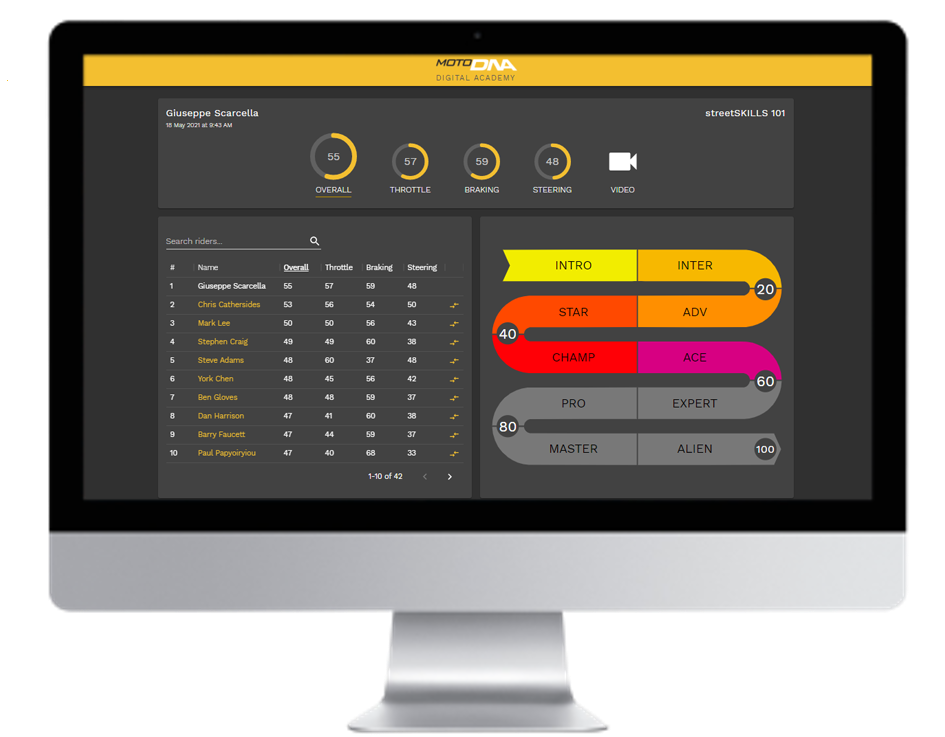Steer the bike with your eyes! You go where you look!
How often have we motorcyclists heard these phrases?
Looking where you want to go obviously relates to vision, an important sense for everyday life, however when we introduce motorcycles, the importance of vision increases dramatically, not just as an essential tool for high performance riding and racing but also for survival on the road.
The fact is most of us are damaging our vision, namely our peripheral vision with our modern lifestyle of sitting in front of TV and computer screens. Compared to our ancestors, our visual field has narrowed dramatically.
Use It Or Lose It
If we get into the habit of looking directly at objects while restricting the awareness of our surrounding field of view, it’s comparable to not fully using other areas of our body. For example if we routinely only bend our knee ten degrees, you could imagine this bad habit of restricted movement would ultimately lead to poor function, soreness and long term damage.
It’s safe to assume that our vision also follows the familiar “use it or lose it” rule that is evident in other areas of our body.In other words, if we only use one part of our visual field, the rest of our visual circuitry will begin to go inactive.
So how important is peripheral vision to our riding and what can we do to increase our visual performance?
Peripheral Awareness – Essential For Survival
Peripheral vision is the part of vision that occurs outside the main focus of gaze or the means to know what’s happening around you without turning your head. The loss of peripheral vision is commonly referred to as ‘tunnel vision’.
The role of peripheral vision is to spot the predators that lurk around us, originally tigers and nowadays more like cars and trucks or other riders and hazards that can do us harm. On the track, peripheral vision is a mega important skill essential to cutting fast laps, on the road its essential for survival.
Peripheral awareness is also linked to balance, movement, reaction speed, reduced mental fatigue and believe it or not intelligence. Its powerful stuff and improving our vision and, with training, our riding is there for the taking.
Information from the peripheral retina goes directly to the centre of the brain rather than to the brains visual centres. This means that your reaction speed is increased by using your peripheral vision. Boxers and martial artists know this. They don’t look directly at their opponent’s fists or feet, and can react quicker as a result.
Target Fixation
Good peripheral vision increases optimum awareness of your overall visual environment. The more aware we are of our surroundings the easier it is to move around.
As a motorcycle trainer for 30 years, I see limited peripheral vision linked to a load of riding errors like target fixation, getting lost in turns, inconsistency, running wide, disorientation, mental fatigue, etc
Most riders also don’t look far enough ahead; however you can also look too far ahead; getting lost in the turn, hence peripheral vision is only part of the equation. You also need to understand how to apply it to your riding.
Your Minds Eye
Fortunately, we can improve our peripheral vision by practising certain exercises, however, how many of us actually practise or exercise appropriate vision techniques to develop this much overlooked skill?
Next time you are riding down the highway, use your peripheral vision or your minds eye to look at the vehicles around you whilst keeping your eyes looking ahead.
You will be surprised by what you are able to see with your minds eye, different colours, and different types of vehicles and also look out for an important benefit – a slower sense of speed. If you are on the track, you may want to use more advanced vision enhancement techniques such as light reaction training to improve reaction times and enhance peripheral fields of vision.
Practise Makes Perfect
Vision, is a dynamic process that involves combining skills of aiming, tracking and focusing, along with a bunch of other mental and neurological processes. So how does peripheral vision help us on the track or road?
To figure this out, let’s consider the elements needed to negotiate a corner, elements known as reference points (RP), these guide us and are vital to help prevent getting lost in the corner. Typical reference points include, braking point, turn in point, apex point and exit point.
The trick is to look ahead, but not too far, and lock in these reference points with your eyes then use your peripheral vision to judge distance and track your motorcycle between those points. On the road you will be scanning too, looking for potholes, oil spills, gravel, etc
There’s so many ‘experts’ online these days, so it’s super important to learn the correct techniques and then do lots of practise, ideally in a controlled environment to reduce the risk from small mistakes.
So make a plan, get training and improve your riding out of sight!
About the Author: Mark McVeigh
Data Driven
Developed from thousands of riders at the motoDNA Motorcycle Training, our algorithms measure, grade and train motorcycle riders.
Objective
No more guessing, data sensor fusion combined with our algorithms deeply understand rider behaviour.
Towards Zero
Our urgent and ambitious aim is to empower the motorcycle community to take back control towards zero.


